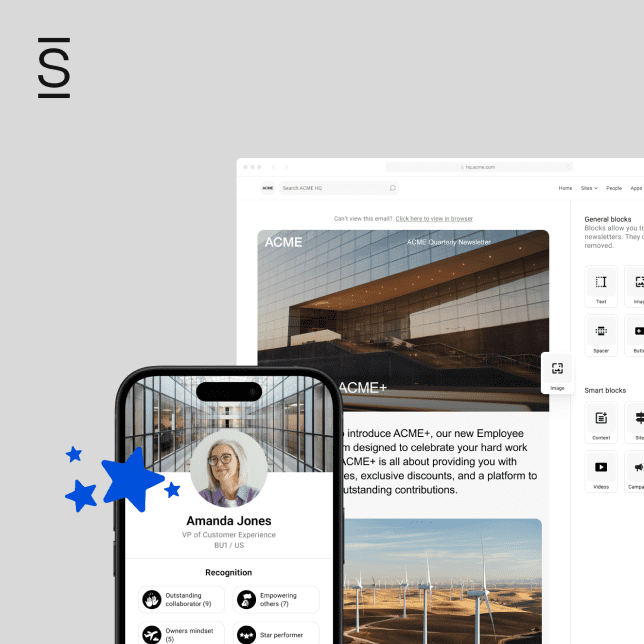Every day our solution consultants are asked why Simpplr is better than SharePoint. And it’s understandable. For organizations that use the Office365 suite, SharePoint is almost always evaluated as an intranet option. Oftentimes, a Simpplr prospect has already implemented SharePoint at least to some extent, using it for documentation and as a central place for employees to find core company resources. They suspect that they could be doing more with their intranet, and they want to know: What makes a modern intranet like Simpplr so great that they should consider leaving their existing SharePoint behind?
But if we dig deeper, we see that we’re having the wrong conversation. As many Simpplr customers can tell you: Simpplr and SharePoint actually complement each other quite well, in large part because they serve different needs and use cases. For organizations already using SharePoint, Confluence, or similar platforms, adding Simpplr can elevate the digital workplace beyond files and wiki pages, and into a more immersive and engaging virtual headquarters.
Knowledge intranets
The original intranets, dating back to the early days of computing, were built with IT departments in mind, emphasizing knowledge management and networking components. Among the main requirements for a traditional intranet:
- The intranet should serve as a single source of truth for all documents and knowledge.
- Ideally, it connects to the rest of the digital workplace and serves as a storefront for other apps (because intranets can help drive adoption of other apps, too).
- The ROI argument rests on productivity: “It should be easy for employees to find stuff.”
Employee Experience intranets
Over time, new stakeholders have muscled into the intranet conversation: internal communications, human resources, and employee experience teams. These functions are tasked with driving employee engagement and keeping everyone aligned with the company strategy. And they have a different set of requirements:
- It should be more than knowledge management. At Simpplr, we’ve coined the term “virtual headquarters” to explain the purpose of a modern intranet. It’s a place where all employees go to connect with coworkers and engage as a community across physical locations and departments, build culture reaffirming the company’s purpose, align with leaders on strategy, and find trusted/curated information. That way employees can feel included, stay in the know, find help, and connect with their coworkers.
- The intranet should feel more like a news app than a document repository.
- The intranet needs to be easy for Internal Communications to directly administer because they can’t move fast enough with IT dependencies. This is required to create a vibrant community that can serve as a virtual headquarters.
Because the intranet is used by all employees across the organization, the intranet is an extension of the employee experience. Experience matters: The community is a reflection of the employer brand, so ideally the intranet needs to be inviting and intuitive.
“Build vs buy”
SharePoint is a platform technology, whereas Simpplr offers a prepackaged, purpose-built intranet (or what Gartner calls “Intranet as a Service”). With the flexibility of SharePoint and other traditional intranets like Confluence, you certainly can build an employee experience-oriented intranet. But doing so requires extensive expertise, budget, time, and effort. SharePoint intranets don’t simply work out of the box, they need to be built and configured with technical resources much like other platform technologies such as Google Sites.
There are several reasons SharePoint and the like are better suited as a Knowledge Intranet than an Employee Experience intranet:
- SharePoint and Confluence provide toolkits but still needs to be assembled
- Traditional intranets not optimized for usability, design, and the engagement use cases referenced above. Plus, IT departments typically have technical skills but lack usability and design experts.
- A highly custom implementation that is intended to serve as an employee experience hub takes a long time to get off the ground — averaging more than one year, according to some estimates.
- They need to be maintained by technical resources who have been certified in SharePoint-specific configuration. This creates maintenance complexity and makes the intranet’s total cost of ownership (TCO) skyrocket because you have to dedicate expensive technical resources to the platform. IT bottlenecks can slow down processes and prevent key messaging and resources from being delivered quickly and with agility.
- Since most implementations are heavily customized, they can’t be easily upgraded or leverage new features.
For a more detailed analysis of the build vs. buy conversation, see our blog post.
Traditional and modern intranets can coexist
With our customer base, Simpplr has more integration breadth across SharePoint and other Microsoft products than any other technology stack. And rightfully so. Any intranet will need deep integrations to succeed in an Office 365 shop.
Using SharePoint and Simpplr together has meaningful advantages over using SharePoint alone:
- Improve engagement and adoption: Simpplr’s beautiful, intuitive user experience serves as a superior primary interface to discover and access any and all company communications and resources — regardless of where those resources are hosted.
- Decrease the risk of intranet failure: Avoid the most common pitfalls — endless implementation, stale content, disengaged executives, generic experiences, etc.
- Boost reach and visibility: Omni-channel communication — across devices, media types, and channels — fosters a workforce that buys in and rows together. Simpplr’s cross-channel promotion tools, advanced targeting options, and branded mobile app experience make it possible.
- Eliminate IT bottlenecks: Distributed, point-and-click administration means IT can use bandwidth where they add more value.
- Improve productivity: Centralize search across all file systems and knowledge bases to create a single source of truth and improve velocity.
- Reduce tickets and one-off requests: When everything is easy to find, internal communications, HR and IT can reduce time spent fielding requests and focus on strategic initiatives.
Conclusion: Simpplr and SharePoint
Simpplr can coexist with SharePoint, Confluence, and other traditional intranets, but more than that, Simpplr vastly improves the overall experience. Simpplr adds essential UX and functionality to create a true virtual headquarters, making knowledge intranets more discoverable and valuable in the process.














